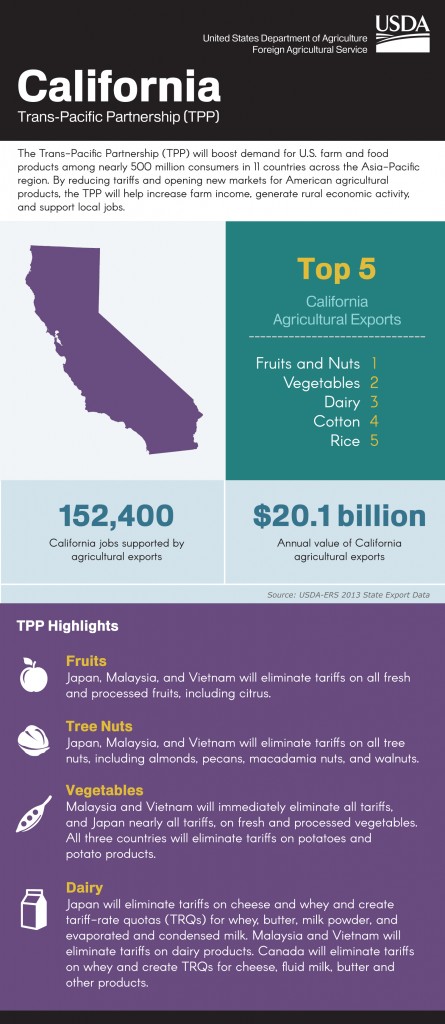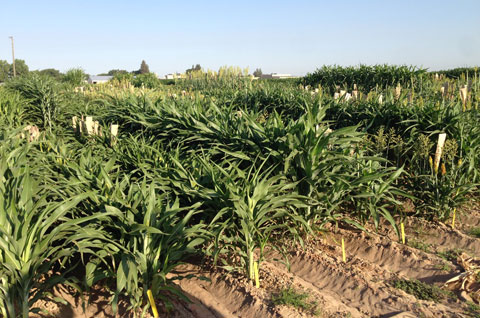
Photo by Lezlie Sterling – Sacramento Bee
By Ryan Lillis
It’s harvest time in Sacramento Valley rice country, and like a lot of farmers in the state, rice grower Fritz Durst loves the idea that California agriculture helps feed the world.
It’s more than an idle boast. Traditionally, nearly half of the state’s agricultural output is shipped each year to international destinations, from Mexico to the Middle East, yielding $20 billion annually in sales.
This year is shaping up differently, however. A fourth debilitating year of drought has put California’s role in the global food chain to a test. Some commodities are coming up short, and exports are beginning to suffer.
Anxiety about the shift runs high in the Sacramento Valley. The rice crop is likely to run at least 30 percent smaller than normal because of water shortages. As a result, Northern California growers have lost customers in traditionally strong markets in the Mediterranean and Middle East.
Rice grown in Arkansas and other Southern states has filled much of the void, along with rice from Europe and Australia. It’s likely just a temporary shift. But after back-to-back years of weak crops, some Sacramento Valley growers are starting to worry about their long-term international prospects even if El Niño packs a serious punch this winter, as some forecasters predict.
“I’m concerned because once you lose a market … people get accustomed to someone else’s product,” said Durst, a fifth-generation Knights Landing farmer, as he trudged through one of his fallowed fields. Durst, who grows rice and other commodities in Yolo and Colusa counties, planted just 300 acres of rice this year, half the normal amount.
Many trade experts say California should be able to recapture the lost overseas markets once the drought ends, water supplies improve and the rice crop bounces back. Sacramento Valley rice, widely found in sushi restaurants, is considered superior in quality to what’s grown in the South. Even California’s competitors say so.
“We’re not a threat to California,” said Bobby Coats, a farm economist and trade expert at the University of Arkansas. “Any market share we gain from California will not be sustained in the future, end of story, until we come up with a better product.”
Nevertheless, some doubts have crept in among California rice exporters. Along with the effects of the drought, they’re also getting clobbered by the strength of the dollar, which makes U.S. goods more expensive overseas. Southern farmers obviously have to deal with a strong dollar, too, but they have lower growing costs and can sell their rice for about one-third less than their California counterparts.
Eager to capitalize on California’s drought, Southern farmers last year doubled their production of medium-grain rice, the variety that’s often exported. Figures for this year aren’t yet available, but it’s clear the Southern growers are making inroads in countries such as Lebanon, Turkey, Libya and Jordan.
“Those countries will take Southern rice if the California rice is not available,” said Nathan Childs, a U.S. Department of Agriculture economist. “This movement was caused by the drought. It was not a change in preference caused by taste.”
One boon for California is that sales to the major export markets, Japan and South Korea, have remained intact, said Kirk Messick, senior vice president at Farmers’ Rice Cooperative, a Sacramento-based marketing company. Messick said he thinks the other customers eventually will return.
For now, though, Messick said the loss of business in the Middle East and Mediterranean have hurt. Overall exports have fallen by more than 20 percent in the past year, and the prospects for this year’s stunted crop aren’t terrific.
“We’re going to lose demand,” Messick said. “We could lose domestic markets as well.”
The concerns aren’t limited to the rice business. The supply of almonds, one of the most important commodities grown in California, is expected to shrink by 4 percent. “We’ll just have to see how we can best satisfy that demand as the year progresses with a smaller crop,” said Julie Adams, a vice president of the Almond Board of California, in an email. California growers sold $4.2 billion worth of almonds overseas in 2013, more than any other commodity. More recent figures weren’t available.
Pistachio production seems to have been hurt by the drought as well, although it’s too soon to say how big the crop will be and what impact that will have on sales to China and other key markets. “With the high demand that has been in place for pistachios around the world, we could sell much more than what we have,” said Richard Matoian, executive director of American Pistachio Growers, a trade group based in Fresno.
Jock O’Connell, a Sacramento economist and trade consultant, said international food processors and importers are growing restless about California’s weather patterns and water supplies, and are exploring alternatives.
“Guys overseas are pretty shrewd,” said O’Connell, who analyzes international trade trends for Beacon Economics of Los Angeles. “They’re looking around and saying, ‘How reliable will California growers be,’ and they have plenty of reason to be skeptical.
“There’s a lot of talk in the ag sector about the danger of (California farmers) becoming unreliable suppliers,” he added. “There’s a chance it will open up opportunities for growers in other regions of the U.S., and other countries.”
The California Department of Food and Agriculture says California exported $704 million worth of rice in 2013, the last year for which figures are available. That year, some 560,000 acres were harvested, a fairly typical season. This year, the harvest will encompass only 375,000 acres, according to the California Rice Commission. Export sales are sure to fall.
Ordinarily this is Durst’s favorite season, the two-week sprint to bring in the rice crop. “It’s like watching your child graduate from college,” he said. “It’s what you work for.”
This year, with only half his rice fields planted, the experience is bittersweet.
The sharp cutbacks have as much to do with the timing of water deliveries from the state’s government-run plumbing network as they do with the total supply of water. Compared with areas south of the Delta, water is actually fairly plentiful in the Sacramento Valley. But this spring, regulators kept more water than usual in storage at Lake Shasta, as part of a complicated effort to keep water temperatures lower in the reservoir to assist winter-run Chinook salmon. That meant much of the water didn’t arrive in time for spring planting.
“We couldn’t get our water deliveries when we needed them,” Durst said.
It was hardly a financial loss for most farmers. Though they couldn’t plant their full crops, many in the Sacramento Valley were able to sell much of the water that did arrive. A deal with the San Luis Delta-Mendota Water Authority, a large agricultural agency in the parched San Joaquin Valley, generated plenty of revenue: more than $600 per acre-foot of water.
Durst, one of those who participated in the sale, said he’ll probably make more money from that transaction than he would producing rice. But he called water sales a “Band-Aid” and not a permanent fix for the Sacramento Valley’s water problems.
“My business is to grow rice,” Durst said, adding that the massive fallowing has hurt the regional economy. “Some of the rice warehouses are struggling because they don’t have enough inventory. The trickle-down effect is going to be felt here.”
The impact is global. California rice farmers have spent decades pushing to get their products sold overseas, with considerable success. While California generates only a quarter of U.S. rice production, until recently it has been responsible for a third of the exports. A big part of the story is a 1993 trade agreement known as the Uruguay Round, which opened doors in Japan and South Korea. All told, anywhere from 55 percent to 65 percent of the California rice crop is exported, Messick said.
Now, the industry worries about backsliding.
“You work very hard to gain markets and it takes a long time to gain those markets back,” said Tim Johnson, president of the rice commission. “Next year is far from certain, even if we have a normal planting year.”
Full article: “Exports suffer as California rice crop takes hit in drought” from the Sacramento Bee








